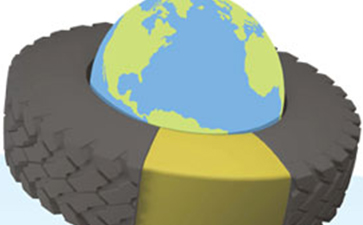Construction Equipment Performance Depends on Quality Tire Technology
There is no industry that relies more on the strong performance of physical equipment and assets than the construction field. On-the-job productivity literally depends on how efficiently materials can be moved and hauled, without incident, from “point A” to “point B.” And, this task must be completed over and over again, every hour on the hour—on job sites around the globe. Not only does Off-the-Road (OTR) equipment need to rise to the challenge of meeting the demands of a busy construction site—without breaking down in the field—but it also needs to operate at optimal performance to keep activity flowing full-speed. Savvy project managers turn to heavy equipment options that will enable them to stay on time—and on budget.
Construction vehicles such as bulldozers, excavators, haulers, telehandlers and wheel loaders are truly the workhorses that keep a smooth build site running. If one or more essential pieces of equipment should happen to malfunction, the entire project can grind to a speedy halt. Just ask any project manager whether an unwanted tire flat can ruin jobsite productivity—and they will likely regale you with an ear full of stories about development efforts gone wrong as a result of transportation mishaps.
As construction activity continues to rise on a global scale, equipment and technology will play a paramount role in the upcoming year. Especially for sites requiring rigorous groundbreaking with rugged terrain, commercial construction vehicles will take center stage—and be expected to turn out and maintain a high level of operational success to feed a growing market.
According to Mordor Intelligence, the global equipment rental market will reach $174.52 billion by 2026. The type of equipment that will figure most heavily in this expansion will be large pieces of machinery—such as wheeled excavators that dominate the earthmoving equipment segment.
These types of vehicles also have specified tire technology requirements.
Heavy vehicles are especially vulnerable to unexpected tire punctures. If an essential piece of equipment sustains a flat, it can significantly impede project management efforts for the day, or even the week. Not to mention the fact that construction equipment tires are difficult and costly to replace. Downtime of any kind in the residential or commercial building sector is a logistical headache.
This is where proper tire selection comes in play. There are many types of tire technologies for construction operators to evaluate, but only one format—tire fill, or “foam fill”—virtually eliminates the risk of tire puncture. Why? Tire fill is comprised of a polyurethane fill injected into pneumatic tires, which basically renders the tire completely flatproof. Commercial and industrial-grade tires using tire fill technology can glide easily across a worksite cluttered with even the worst kinds of debris. That’s because foam filled tires are impervious to nails, sharp rocks, glass, wire and rebar—making this type of tire solution a desirable option for large equipment operators.
In addition to their reliability in the field, foam filled tires are far safer from an operational standpoint for a variety of reasons:
First, they offer a choice of durometer—allowing operators to select hardness and tire deflection characteristics, depending on the job at hand. Unlike solids, which, due to their heaviness, can become less stable (for example, on a slanted hillside terrain), tire fill technology’s ability to let OTR equipment supervisors customize durometer is a definite safety feature. While solids are at risk of losing traction in muddy or less than desirable conditions, tire Fill is consistently stable.
Second, tire fill technology offers a measurably more comfortable ride. Solids are stiff and less flexible. According to For Construction Pros, solids’ “thick rubber, while impenetrable, also provides the least comfortable ride and adds a considerable amount of weight.” OTR drivers pulling long shifts behind the wheel are subject to a rough, and often bumpy and jarring, experience when riding on solids.
This jolting ride—which delivers G-force vibration-to both the driver and the vehicle itself—is known in the industry as “Solid Shock.” Solid Shock refers to the harsh impact from solid aperture tires. Not only is Solid Shock a major source of wear and tear on machines, but it may cause Whole Body Vibration or “WBV.” WBV is a real condition that has been linked to adverse health effects, including lower back pain, headaches, joint pain, and fatigue.
Not only does WBV have safety implications, it also can sideline drivers for weeks and months if they can’t properly perform their jobs. This, in turn, can cost construction companies big dollars in lost productivity and worker compensation.
While there are many considerations that builders and project managers must make when evaluating their transportation needs and requirements, it’s important not to ignore the truly substantial role that appropriate tire technology decisions can play in the overall smooth functioning of a construction site. Tires may seem to be a lesser-known factor in smart operations, but they can impact the way an entire worksite “rolls” when time, money and logistical efficiencies are on the line.
To learn more, get in touch with a Carlisle TyrFil representative to discover more about the many benefits of foam fill technology and accompanying tire care solutions. Or visit us at Booth #C22400 at the upcoming ConExpo Show held in Las Vegas, NV – March 10-14, 2020.


